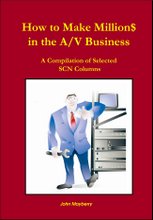The lack of Adobe Flash playing capability on Apple devices is more than just annoying- it's stupid and impossible to logically justify. Apple's Steve Jobs has repeated refused to integrate it into their systems and tried to justify it publicly. Now Adobe's Narayen is firing back...
Apple CEO Steve Jobs has shunned Flash on mobile devices, throwing his support behind an emerging standard called HTML5. Apple is the only one of 20 smartphone makers that doesn't let users view Web sites containing animation, videos and other content created in Flash, Narayen said. Apple doesn't support Adobe's Flash in the iPhone, iPod music player or iPad tablet.
http://www.mercurynews.com/breaking-news/ci_14421098
Thursday, February 18, 2010
Friday, February 12, 2010
"Main Street" Electrical Parade Going South
Less than eight months after the debut of the new and improved Electrical Parade at Disney’s California Adventure, the popular attraction is being boxed up and shipped to the Magic Kingdom.
The long-running parade will reclaim its former name, the Main Street Electrical Parade, when it premieres in Florida in June.
No word yet on if the parade will ever return to California. California Adventure is expected to debut the new World of Color nighttime show this spring.
Wednesday, February 10, 2010
Google to Offer 1 Gig Data Service
Google Inc. said it will begin selling ultra-fast Internet access to consumers, a test that could threaten existing telecommunications carriers' grip on the Web and is designed to show off new uses of the Internet at high speeds.
Under the plan, Google will build an experimental fiber network that will target several cities and between 50,000 and 500,000 people, the company announced Wednesday. Google said it would offer service at a speed of 1 gigabit per second—or 100 times faster than what many U.S. consumers are used to—and would offer the service at "a competitive price."
Under the plan, Google will build an experimental fiber network that will target several cities and between 50,000 and 500,000 people, the company announced Wednesday. Google said it would offer service at a speed of 1 gigabit per second—or 100 times faster than what many U.S. consumers are used to—and would offer the service at "a competitive price."
Monday, February 8, 2010
The FCC, Wireless Microphones, and Licensing- ACT NOW
FCC REVISING WIRELESS MICROPHONE LICENSE ELIGIBILITY
Deadline For Comments February 22, 2010
After nearly 35 years, the Federal Communications Commission is considering expanding its licensing rules for wireless microphones, in-ear monitors, production intercom systems, and similar equipment that operates in the television broadcast (VHF and UHF) band.
Until now, only broadcasters, motion picture and television program producers, and similar entities were eligible for licenses. The FCC is aware that wireless microphones are used today by musical performers, houses of worship, theaters, schools, businesses, and many other types of entities.
The FCC permits wireless microphone operation either with or without a license. However, in the near future, licensed users may be afforded greater protection against interference from future consumer wireless TV Band Devices (both fixed and portable) that will operate in the same spectrum as wireless microphones.
The FCC is seeking comments from wireless users that will assist them in determining who should be eligible for a wireless microphone license. They need to know how you use wireless systems and how your productions and/or your business would be affected by sporadic interference from new TV Band Devices.
If you rely on wireless audio equipment, it is critical that you submit comments to the FCC before the deadline of February 22, 2010.
For guidelines on how you can submit comments on this issue, send an email message to wirelessmicrophones@shure.com. You will receive a reply message with details on what information must be included in your comments and how to file them with the FCC.
Deadline For Comments February 22, 2010
After nearly 35 years, the Federal Communications Commission is considering expanding its licensing rules for wireless microphones, in-ear monitors, production intercom systems, and similar equipment that operates in the television broadcast (VHF and UHF) band.
Until now, only broadcasters, motion picture and television program producers, and similar entities were eligible for licenses. The FCC is aware that wireless microphones are used today by musical performers, houses of worship, theaters, schools, businesses, and many other types of entities.
The FCC permits wireless microphone operation either with or without a license. However, in the near future, licensed users may be afforded greater protection against interference from future consumer wireless TV Band Devices (both fixed and portable) that will operate in the same spectrum as wireless microphones.
The FCC is seeking comments from wireless users that will assist them in determining who should be eligible for a wireless microphone license. They need to know how you use wireless systems and how your productions and/or your business would be affected by sporadic interference from new TV Band Devices.
If you rely on wireless audio equipment, it is critical that you submit comments to the FCC before the deadline of February 22, 2010.
For guidelines on how you can submit comments on this issue, send an email message to wirelessmicrophones@shure.com. You will receive a reply message with details on what information must be included in your comments and how to file them with the FCC.
Wednesday, February 3, 2010
First Recorded Sound- Ever
Thomas Edison wasn't the first person to record sound. A Frenchman named Edouard-Leon Scott de Martinville actually did it earlier.
He invented a device called the phonautograph, and, on April 9, 1860, recorded someone singing the words, "Au clair de la lune, Pierrot repondit." But he never had any intention of playing it back. He just wanted to study the pattern the sound waves made on a sheet of paper blackened by the smoke of an oil lamp.
Have a listen (1860 version): http://www.nytimes.com/2008/03/27/arts/27soun.html
Subscribe to:
Comments (Atom)




